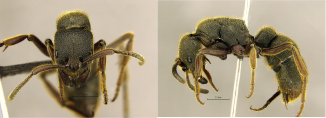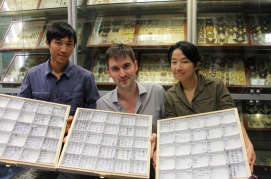Media
Looking for biodiversity? Follow the ants.
- An international team from HKU and OIST launches the first online “antmaps” to visualise the global distribution of ants including 170 species from HK
06 Aug 2015
The team of HKU Insect Biodiversity and Biogeography Laboratory introduces the newly launched antmap website they built up with OIST (from the left: PhD student Mr Roger Lee Ho, Assistant Professor Dr Benoit Guénard and Research Assistant Miss Ying Luo).
Loss of biodiversity is a major concern for scientists and most governments around the world. Nevertheless, the understanding of the composition and geographic distribution of global biodiversity is still largely incomplete. This is best exemplified by the absence of synthesis on global distribution of insects, though their exceptional biodiversity of over 1.1 million species represents the vast majority of species on Earth (with 50% to 90% of insect species still undescribed/unknown). This knowledge gap represents one of the fundamental questions to be addressed in the frontier of macroecological studies, facilitating the devising of efficient conservation plans.
Dr. Benoit Guénard, Assistant Professor of School of Biological Sciences at the University of Hong Kong (HKU), in collaboration with Dr. Evan Economo from the Okinawa Institute of Sciences and Technology (OIST) Graduate School, have spent four years addressing the knowledge-gap problem by building a global distribution database and a website to visualise their results. Since studying all insects would be an insurmountable task, they are focusing on ants, one of the most abundant and ecologically important group of insects. With 15,000 species described, and another estimated 10,000-15,000 more species to be described and categorized, ants are ubiquitous and one of the best studied among insect groups, making them a perfect system to approach this question.
Current progress on their results can now be tracked on antmaps.org (http://antmaps.org/). With just a few clicks, entomologists can inquire about the distribution of thousands of species, account for the species diversity for any region of the world, or compare the similarities of different regions with one another.
Tropical and subtropical regions like Hong Kong are not only home for the majority of species on the planet but also the least studied regions of the world. With the exception of a handful of well-sampled hotspots, most tropical regions of the world are in urgent need of ant (as well as other insects) exploration. This is especially pressing considering the small range of many insect species discovered and the increasing pressure of habitat conversion for urbanization of agriculture. Simply put, if no efforts are made, thousands of species will disappear before we even had the chance to look at them. By developing a new tool like antmaps.org, the research team aspires to foster species exploration and increase species description rate.
170 ant species recorded in Hong Kong
Locally, the website antmap.org informs us that 170 species and 228 species have been recorded in Hong Kong and Guangdong province respectively, of which 114 of the species are shared in both regions. Those who take the time to study ants in detail will be fascinated by their diversity of shapes, sizes, colours or behaviours. Here below are some examples of Hong Kong species:
The species named Pseudoneoponera rufipes produce foam as a defensive mechanism, other species known as army ants (species of the Dorylus and Aenictus genera) are able to capture prey a hundred times larger than a single worker, other ant species create complex nest structures the size of a rugby ball by sewing leaves together (the weaver ant Oecophylla smaragdina) or build tube-like shelters over the “cattle” insects they protect (Crematogaster species), while another species displays the fastest animal movement known (Odontomachus species) by completely closing its mandibles in about 0.4 millisecond (0.0004 second). All these natural wonders are happening right here and many more are waiting to be discovered in Hong Kong and all over the world.
Until a year ago, most of the work realized on ants in Hong Kong was done by Dr. John Fellowes, Honorary Assistant Professor of HKU Kadoorie Institute, nearly 20 years ago. In the view of this, Guénard’s team members in HKU’s Insect Biodiversity and Biogeography Laboratory recently started in Hong Kong the ecological and behavioral exploration of these astonishing creatures with the aim to further enrich the knowledge of biodiversity in ants in the territory. For less than a year the team has conducted several surveys to gain better knowledge of local ant fauna and the results are astonishing. While this work is still at its beginning and focuses only on species present in leaf litter, it has already allowed the identification of 15 newly recorded ant species and potentially a dozen of new species for science. This represents an increase of 16% of the ant fauna known in the territory and it can be expected that more will be discovered.
One of the most significant discoveries is the collection of a tiny new species of Leptanillinae (Figure 2), a subfamily of ants thus far unknown from southeast China, with the closest geographic records for this subfamily reported in Hunan province and Taiwan. Incredibly, this species was collected in Lung Fu Shan Country Park - just a few hundred meters from the Laboratory. Another newly recorded ant species from Hong Kong - the dracula ant, Stigmatomma rothneyi – is shown in Figure 3 below. Indeed, anybody in Hong Kong could find a new insect species in their backyard or in the park they visit over the weekend.
Two extremes in size within the Hong Kong ant fauna (figure 2)
Figure 3. The dracula ant, Stigmatomma rothneyi, one of the newly recorded ants from Hong Kong (head and profile views)
The surveys will also provide important information about the distribution of unwanted, invasive ant species in Hong Kong. The spread of the fire ants (Solenopsis invicta) or other non-native species is important to monitor, and we are in critical need of information on their impacts on native fauna and flora of Hong Kong. Most importantly, early detection of invasive species is vital for efficient control of these populations and prevents further spread. This can only be achieved through regular monitoring and development of solid baseline knowledge on both native and non-native species.
The team will extend its study to other parts of China and Asia as well, potentially some of the most diverse regions in the world. Information gathered will contribute to the continuous update of antmaps.org, while development of new tools such as high resolution imaging to highlight the diversity and complexity of ants and other insects will increase accessibility for students and a broader audience.
Antmaps.org: http://antmaps.org/
To learn more about the Insect Biodiversity and Biogeography Laboratory and its research, please visit: http://benoitguenard.wordpress.com/
Media enquiry:
Communication and Public Affairs Office Ms Rhea Leung (phone: 2857 8555/ 9022 7446; email: rhea.leung@hku.hk)
Faculty of Science Ms Cindy Chan (phone: 3917 5286/ 6703 0212; email: cindycst@hku.hk)
The team of HKU Insect Biodiversity and Biogeography Laboratory displays exhibits of ant species (from the left: PhD student Mr Roger Lee Ho, Assistant Professor Dr Benoit Guénard and Research Assistant Miss Ying Luo).




